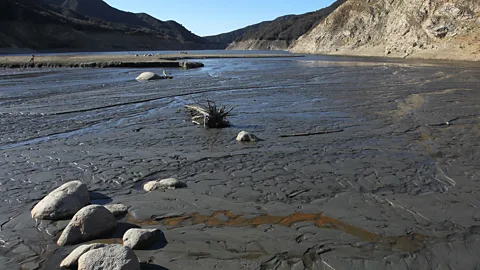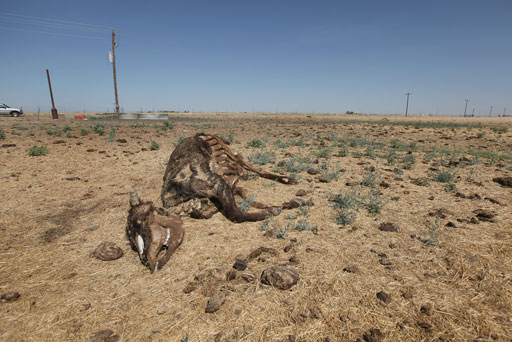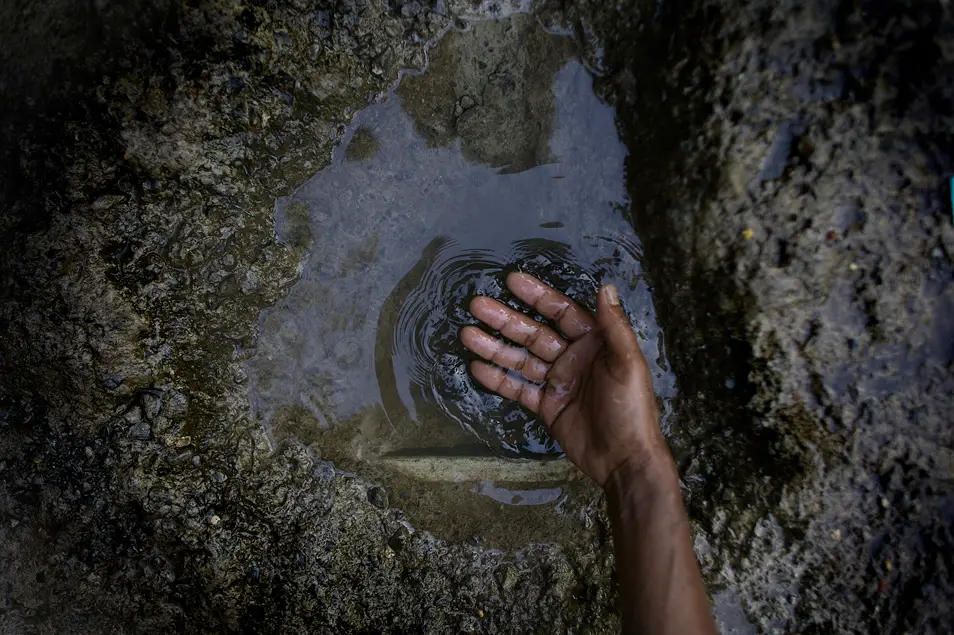It’s ironic that on a planet that is 70 percent water, people still don’t have enough clean, safe water to drink and a water shortage can affect you no matter where you live in the world. It’s arguably humanity’s most vital natural resource. It sustains all other activities; it’s the essential basis of economies, societies, and human life. What would happen if Earth ran out of water?
Timeline:
- Panic & rationing start as H2O scarcity becomes evident
- Within months, cities worldwide face H2O shortages
- Agricultural collapse-food shortage
- Health crises escalate-lack of clean H2O
- Economic turmoil as industries reliant on H2O fall
- Social unrest-mass migrations begin
- Global war erupts over remaining H2O
The freshwater on Earth makes up just three percent of the water supply. Less than one percent is freely available; the rest is tied up in ice, as in icebergs, glaciers, and snowcaps. This means that all of the rivers, streams, lakes, aquifers, and groundwater expected to sustain the 6,602,224,175 people on Earth make up less than one percent of the total water on the planet.
Introduction:
The idea of Earth completely running out of water is hard to imagine because of the vast amounts of water on the planet. However, we can see how water is becoming exceedingly scarce and the critical importance of water, where it’s already a crisis. By 2025, two-thirds of the world’s population may be facing water shortages, studies show.
In the realm of global challenges, few scenarios evoke as immediate a sense of urgency and existential threat as the prospect of Earth running out of water. Water, essential to all known forms of life and integral to human civilization’s development, sustains ecosystems, agriculture, industry, and daily life.
Our global water supply is not unlimited, and its value is increasing with each passing day. If the earth were to run out of water, the consequences would be disastrous. It would affect everyone on our planet, no matter where they are located. There would be far less of the color green since all vegetation would die a slow death, and wind fluctuations would rule most of our weather conditions.
Since the oceans are our greatest carbon sink, without them, the Earth would experience scolding hot temperatures. While such an apocalyptic scenario might seem impossible to us, it is no secret we are having trouble with the way we treat our planet’s resources. The crisis we are currently experiencing is a culmination of many factors, but the growth of the global population puts the most strain on water demands.
Here’s a hypothetical timeline of what could happen if Earth were to run out of water.
Year 0-1: Initial Scarcity

Water is becoming an increasingly important issue in the developed world. But this issue is nothing new for other, less developed nations. For centuries, clean drinking water has been hard to come by for many populations, especially those in impoverished nations.
Countries that are unable to address water-related challenges probably will face a confluence of challenges, including greater risk of disease, growing inequality, poor economic growth, and a heightened risk of internal political instability. Shared water resources among states are increasingly likely to become flashpoints as water security diminishes and geopolitical competition grows.
According to the World Bank and Global Trends if current poor water management policies continue, by 2040 water security will decline in many areas that are not naturally water-scarce—such as parts of Central Africa, East and Southeast Asia, and Latin America—and water security will further deteriorate in areas where water resources are naturally in short supply—including large stretches of the Middle East, North Africa, and the Sahel.
In some areas, water may be available, but it’s often disease-ridden, and drinking it can be fatal. In other areas, a viable water supply is simply not available at all. What would happen if a worldwide Water Emergency developed?
Year 1-5: Severe Depletion
As water scarcity intensifies, the world enters a phase of severe depletion, with far-reaching consequences. Global economies start to collapse as water-dependent industries, particularly agriculture and manufacturing, falter. Mass migrations ensue, with people fleeing drought-stricken areas in search of regions with slightly better water availability, leading to overcrowded cities and strained resources.
Conflicts over water become frequent, both within and between nations, as competition for the dwindling resource intensifies. The environmental impact is devastating: aquatic ecosystems collapse, causing a massive loss of biodiversity, while terrestrial ecosystems also suffer due to the interconnectedness of water sources.
Amidst this turmoil, there are urgent efforts to develop and implement desalination and water recycling technologies, but progress is slow and costly, proving insufficient to meet the global demand. Society grapples with unprecedented challenges as it strives to adapt to a world with critically limited water supplies.
Presently according to The World Health Organization:
- Four billion people — almost two-thirds of the world’s population — experience severe water scarcity for at least one month each year.
- Over two billion people live in countries where water supply is inadequate.
- Half of the world’s population could be living in areas facing water scarcity by as early as 2025.
- Some 700 million people could be displaced by intense water scarcity by 2030.
- By 2040, roughly 1 in 4 children worldwide will be living in areas of extremely high water stress.
What if the world enters a phase of severe depletion?
Year 5-10: Critical Phase
In the critical phase of water scarcity, the situation becomes dire as major cities exhaust their water supplies, leading to urban chaos and the breakdown of social order. Persistent food shortages escalate into widespread famine, with malnutrition becoming rampant and starvation claiming lives.
Hospitals and healthcare facilities struggle to maintain basic hygiene, exacerbating the public health crisis as waterborne diseases spread unchecked. The global economy collapses as international trade halts and nations focus solely on internal stability, abandoning cooperative efforts.
With the collapse of essential services and infrastructure, daily life regresses to a focus on mere survival. The combined effects of famine, disease, and conflict result in significant population decline, as humanity faces an unprecedented existential threat. This critical phase underscores the urgent need for sustainable water management and immediate, coordinated global action to mitigate the catastrophic impacts of severe water depletion.
Water rationing in a severe scarcity scenario would involve governments implementing strict and comprehensive measures to manage and distribute the limited water supply effectively. Households would be allotted a fixed amount of water per day, just enough to meet basic needs such as drinking, cooking, and minimal hygiene. Non-essential uses of water, such as watering lawns, washing cars, and filling swimming pools, would be prohibited.
Enforcement mechanisms, such as water usage monitoring and substantial fines for violations, would be put in place to ensure compliance. Priority would be given to essential services like hospitals and emergency services, while industries heavily dependent on water might face severe restrictions or shutdowns. Public awareness campaigns would be launched to educate citizens on water conservation techniques and the importance of adhering to rationing rules to ensure equitable distribution and survival during the crisis.
When waters run dry, people can’t get enough to drink, wash, or feed crops and economic decline may occur. In addition, inadequate sanitation—a problem for 2.4 billion people as of 2024—can lead to deadly diarrheal diseases, including cholera typhoid fever, and other water-borne illnesses.
Urban Desperation
- Water Outages: Major cities, including metropolises in developed and developing countries, experience severe water shortages, with many running out of water entirely. Public water supply systems fail.
- Social Breakdown: Urban areas descend into chaos as residents scramble for any available water. Riots and violent clashes over water access become commonplace.
- Infrastructure Collapse: Essential services, such as sanitation, waste management, and public transportation, deteriorate rapidly. The breakdown of urban infrastructure exacerbates the crisis.

Water Emergencies and Emergency Water Supply-Critical Phase
Widespread Famine
- Agricultural Failure: Continued lack of water devastates agriculture. Staple crops fail, and livestock die off, leading to severe food shortages.
- Food Rationing: Governments implement strict food rationing policies, but supplies are insufficient to meet the needs of the population.
- Malnutrition: Chronic malnutrition has become widespread, particularly affecting children and the elderly. The weakened population becomes more susceptible to diseases.
- Starvation: In the hardest-hit areas, starvation becomes a common cause of death as food supplies dwindle.
Public Health Crisis
- Healthcare Breakdown: Hospitals and healthcare facilities struggle to maintain basic hygiene due to a lack of clean water, leading to the spread of infections and diseases.
- Disease Outbreaks: Waterborne diseases, such as cholera and dysentery, become rampant. In addition, malnutrition-related illnesses surge.
- Mental Health: The psychological impact of the crisis leads to widespread mental health issues, including anxiety, depression, and trauma, overwhelming mental health services.
Economic Collapse
- Global Trade Halt: International trade grinds to a halt as countries focus on maintaining internal stability and securing their own resources. Global supply chains collapse.
- Financial Markets: Stock markets and financial institutions face unprecedented crises. Many banks and corporations declare bankruptcy.
- Black Markets: Black markets for water, food, and essential medicines thrive, often controlled by criminal organizations.
- Barter Economy: In some regions, traditional currency loses value, and barter systems emerge as the primary means of trade.
Population Decline
- Famine and Disease: The combined effects of famine, malnutrition, and disease lead to a significant decline in the global population. Death rates far exceed birth rates.
- Conflict Casualties: Wars and conflicts over water and other scarce resources contribute to high mortality rates.
- Migration Toll: The physical and emotional toll of mass migrations results in high casualties among displaced populations. Refugee camps suffer from inadequate supplies and unsanitary conditions.
- Long-term Impact: The significant population reduction alters social structures, family units, and communities. Entire regions become depopulated.
Years 5-10 mark a critical phase where urban areas face extreme desperation due to water shortages, leading to social breakdown and chaos. Persistent food shortages result in widespread famine and chronic malnutrition. Public health crises escalate as hospitals struggle to operate without clean water, and diseases spread rapidly. The global economy collapses, with international trade halting and financial markets failing.
The cumulative effects of famine, disease, conflict, and migration lead to a significant decline in the global population, transforming societal structures and reducing human resilience. The world enters a period of unprecedented hardship, underscoring the catastrophic impact of severe water scarcity.
Year 10-20: Near Extinction
Water scarcity has escalated to a crisis nearing extinction, where humanity faces the brink of survival. The once abundant resource has dwindled to critical levels, leading to the collapse of agricultural systems, widespread famine, and severe public health crises.
Major cities have run dry, triggering urban chaos, social breakdown, and violent conflicts over remaining water sources. As ecosystems collapse and biodiversity plummets, the interconnected fabric of life on Earth unravels. Scattered, isolated communities struggle to survive, relying on meager local water sources and rudimentary living conditions.
The loss of modern civilization’s infrastructure and technological advancements marks a regression to survivalist behaviors. Without immediate, drastic intervention and sustainable water management, humanity faces the stark possibility of extinction.
Year 20+: Endgame
In the endgame of water scarcity, human civilization is reduced to scattered, small communities struggling for survival near remaining water sources. The collapse of modern society leads to a significant regression in technological and social structures, with knowledge and culture preserved only in fragmented forms. The ecological collapse is nearly complete, with most ecosystems irreparably damaged and biodiversity severely diminished.
Desperate efforts in desalination and water recycling provide limited relief, insufficient to meet global needs. The focus shifts entirely to basic survival, with communities relying on rudimentary technologies and traditional knowledge.
If any semblance of societal structure remains, there is a faint hope for gradual recovery through strict water management and sustainable practices. However, without significant breakthroughs and cooperative efforts, humanity faces the stark possibility of extinction, highlighting the critical importance of preserving and managing our vital water resources.
Conclusion:
In conclusion, the hypothetical scenario of Earth running out of water paints a stark picture of the cascading consequences that severe water scarcity would bring to humanity and the planet. The timeline from initial scarcity to near-extinction illustrates the rapid and devastating impact on every aspect of society, economy, environment, and human health.
From the onset of panic and water rationing to the collapse of industries, mass migrations, and societal unrest, the scenario highlights how essential water is to every facet of human life. As the crisis intensifies over the years, with urban chaos, widespread famine, and health crises becoming the norm, global stability and cooperation falter, leading to a critical phase where survival itself becomes the primary focus.
By the endgame, human civilization has regressed to scattered communities struggling to survive near dwindling water sources. The loss of modern civilization and technological regression leave behind fragmented remnants of knowledge and culture, with the potential for slow recovery contingent upon strict water management and sustainable innovations.
This hypothetical scenario underscores the urgent need for proactive measures in water conservation, sustainable resource management, and international cooperation to mitigate the risks of such a catastrophic water crisis. It serves as a stark reminder of the interconnectedness of human well-being with the health of our planet’s ecosystems and resources, urging us to take collective action to safeguard Earth’s water for future generations.
References:
How Stuff Works- Can We Manufacture Water Out of Thin Air?
FAQ’s





